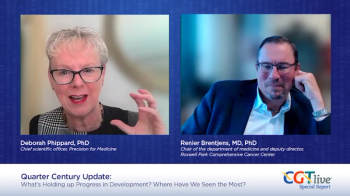
Gene Therapy for Parkinson Disease Demonstrates Safety, Improved Motor Function
From baseline, all participants showed improvements on CGI-Improvement scale scores while all but 1 patient demonstrated improvement on modified Hoehn and Yahr scores.
This content originally appeared on our sister site,
The gene therapy VY-AADC01 (Voyager Therapeutics), provides long-term safety and durability in patients with
The study, conducted by lead author Chadwick Christine, MD, neurologist, Parkinson’s Disease and Movement Disorders Clinic, UCSF Health, and colleagues, found that a single administration of the therapy was well-tolerated and resulted in stable or improved motor function and quality of life across cohorts.
Christine and colleagues assessed safety and tolerability of VY-AADC01, an experimental AAV2 gene therapy encoding the human aromatic L-amino acid decarboxylase (AADC) enzyme in 15 patients aged 40 to 70 years with moderately advanced PD. The treatment was delivered via bilateral, intraoperative MRI-guided putaminal infusions to 3 cohorts, with 5 participants each.
Cohort 1 received the agent at a concentration of 8.3 x 1011 vector genomes (vg)/mL and up to 450 µL per putamen for a maximum total dose of up to 7.5 x 1011 while those in the second cohort received the same concentration, with up to 900 µL per putamen for a total dose of up to 1.5 x 1012 vg. In cohort 3, the concentration was increased to 2.6 x 1012 vg/mL and the volume (up to 900 µL per putamen) kept identical to cohort 2 for a maximum dose of up to 4.7 x 1012 vg.
WATCH NOW:
The primary outcome measure was the safety and tolerability of AADC gene transfer as assessed by the frequency of adverse events (AEs) and serious AEs (SAEs) and their relationship to VY-AADC01 or the trial procedure. Over the 3-year period, the treatment and surgical procedure were found to be well-tolerated, with a total of 4 SAEs reported in 2 participants. Atrial fibrillation and pulmonary embolism were observed in 1 participant while the other had 2 events of small bowel obstruction, all of which were resolved and deemed not related to the gene therapy.
Daily PD medication requirements, measured by levodopa equivalent dose (LED), were decreased from baseline in cohorts 2 and 3 throughout the trial. At the end of the trial, those in cohort 2 had mean changes in LED of –322 mg/day (±124), equating to a 21% decrease, while participants in cohort 3 had mean changes of –441 mg/day (±73), a 30% decrease. LED remained stable at 12 and 24 months for those in cohort 1, but then increased by 343 mg/day (±406) above baseline at 36 months, a 23% increase.
Patients in cohort 1 and 2 also showed improvements in PD diary good ON time, with increases from baseline at the final 36-month follow-up of 2.1 hours (±0.6) and 2.2 hours (±1.7), respectively. Those in cohort 3 demonstrated improvement in good ON time at 12 months that returned to baseline at both the 24- and 36-month mark.
Unified Parkinson’s Disease Rating Scale (UPDRS)-III off-medication scores were improved across all 3 cohorts, with changes from baseline of –19 points (±3.9), –12.2 points (±3.3), and –10.2 points (±4.6), respectively, at the final 36-month follow-up. Those in cohorts 2 and 3 had improvements of –7.8 points (±1.6) and –3.8 points (±1.5), respectively, in UPDRS-III on-medication score that were sustained throughout the entire study period.
From baseline, all participants showed improvements on Clinical Global Impression-Improvement scale scores while all but 1 patient demonstrated improvement on modified Hoehn and Yahr scores. At 36 months, clinicians rated 1 participant as "very much improved," 11 participants as "much improved," and 3 participants as "minimally improved."
Changes in quality of life were assessed using the 39-item Parkinson’s Disease Questionnaire (PDQ-39). Patients in cohort 1 demonstrated stable and comparable PDQ-39 scores to baseline at all annual follow-ups, whereas those in cohort 2 demonstrated steady improvements throughout the trial. Those in cohort 3 had showed improvements at 12 and 24 months, but were returning toward baseline at 36 months.
REFERENCE
Christine CW, Richardson RM, Van Laar AD, et al. Safety of AADC gene therapy for moderately advanced Parkinson disease: three-year outcomes from the PD-1101 trial. Neurology. Published online October 14, 2021. doi:10.1212/WNL.0000000000012952
Newsletter
Stay at the forefront of cutting-edge science with CGT—your direct line to expert insights, breakthrough data, and real-time coverage of the latest advancements in cell and gene therapy.










































